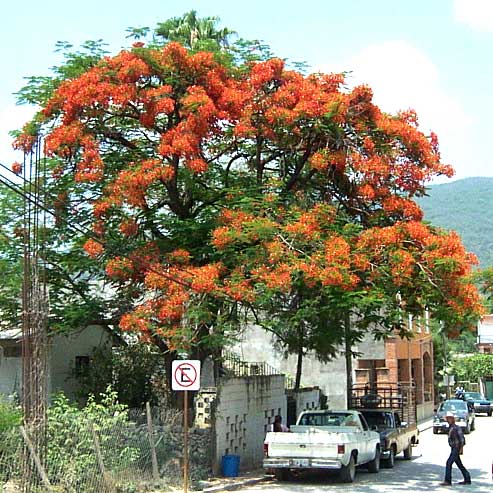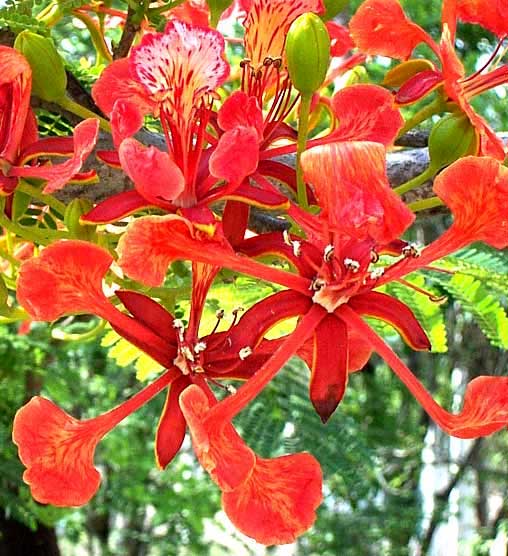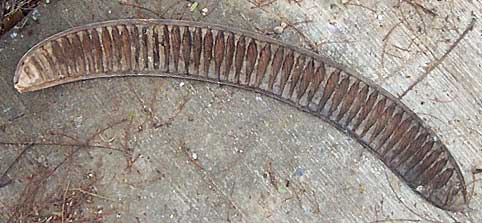Excerpts from Jim Conrad's
Naturalist Newsletter
from the May 5, 2007 Newsletter issued from Sierra Gorda Biosphere Reserve, QUERÉTARO, MÉXICO
POINCIANA DETONATIONS
The Poinciana's time has come and now the early-bloomers are indeed gorgeous. I hadn't noticed their bud-bursting, so their unexpected appearance all across town is like the detonations of beauty-bombs dropped randomly from high above, and maybe that's what they are. You can see a tree I pass on banana-buying days below:

The tree's 3.5-inch wide flowers and handsome, 18-inch- long, ferny, bipinnate leaves are shown close up below:

This is DELONIX REGIA of the Bean Family. Being so widely planted the species bears many English names, including Royal Poinciana, Peacock-flower, Flametree and Flamboyant. In Spanish it's Flamboyán. It's an African tree, from Madagascar, and it doesn't tolerate frost. Jalpan's Poincianas have been utterly leafless the last few months but I read that in other tropical areas with adequate year-round rainfall Poincianas are practically evergreen. In Australia, where it seems every foreign plant can become an ecosystem-threatening invasive, it's a weed-tree pushing aside native species who can't compete with the Poinciana's dense root network and shade.
Despite Poinciana being abundantly planted in the tropics worldwide, it's on the IUCN Red List of Threatened Species. That's because in the remaining forests of western and northern Madagascar where the speices grows naturally, people cut it for making charcoal.
In the above close-up of Poinciana's flowers you can see that the blossoms' long, upward-curved, pollen- producing stamens are very conspicuous, as well as the brightly red petals and sepals. This week I gave a day- long nature-study workshop to a group of local teachers and for our flower-interpretation session we went to a little park next to the reservoir, sat on a stone wall in coolish shade with a breeze off the lake, and used Poinciana flowers as our model for studying flower anatomy. What a delight!
from the January 5, 2007 Newsletter, issued from Sierra Gorda Biosphere Reserve, QUERÉTARO, MÉXICO
POINCIANA PODS ON SIDEWALKS
On a torrid January morning in 1974 or 75 I was a young botanist on my first important botanical expedition. I had waded into a piranha-infested lake in Paraguay's Chaco region -- heroically, I thought, but anything for the sake of science -- to retrieve the most amazing seedpod I'd ever seen. Obviously it was a legume of a Bean Family member, but this pod possessed woody walls and was over two feet long! Surely I'd discovered a new species, something that'd floated in from some unexplored recess of the vast, mostly botanically unexplored wetlands around us.
On my first day back at work at the botanical garden in St. Louis I asked a specialist about my splendid find. It turned out to be one of the most commonplace things in the world, really not even worth keeping, the fruit pod of the Royal Poinciana tree, DELONIX REGIA, a native of Madagascar now abundantly planted throughout the world's tropics. Well, that's how I learned a lot of my botany, by making myself look silly before my colleagues, again and again.
I'm thinking about that little incident nowadays because if you walk more than just a few feet on any sidewalk in Jalpan you're likely to see exactly what I fished from that Paraguayan lake. You can see what it looks like below:

Most pods still hang on the trees, giving the trees a gangly, homely appearance. However, people keep planting Poincianas for one and only one reason: During the rainy season when they flower they are absolutely gorgeous, flamingly-red-blossomed trees. They are much more beautiful in flower than they are ugly in fruit. If I'm here during their flowering season you can bet that I'll photograph one.